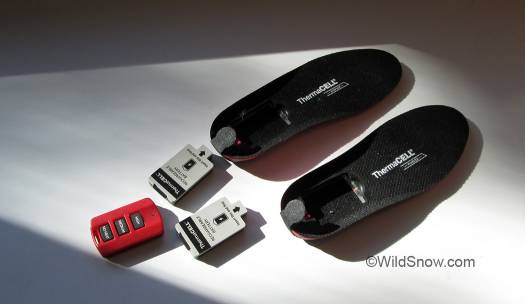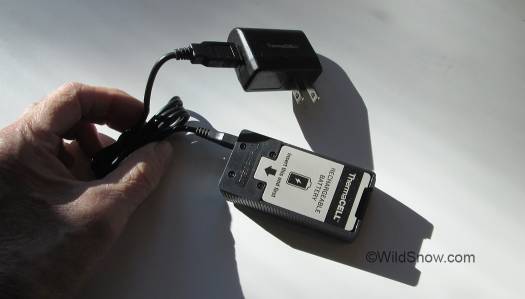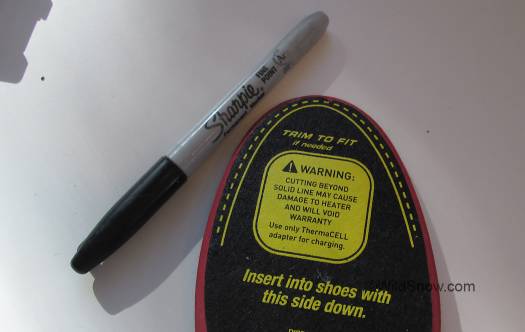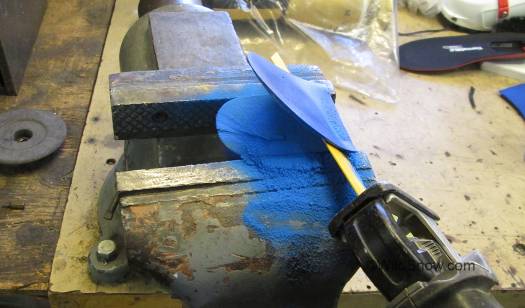I know these guys who like the crisp air on 8,000 meter peaks. They bring skis sometimes too. But their feet get cold. Last winter one of those characters (Mike Marolt) told me his etail business would be selling Thermacell heated boot insoles, and that they “saved my feet and I couldn’t climb without them.” Sure, he sells the things but Mike is a straight shooter so I figured the insoles would be worth a test. Mike was right, they really do work. A few trade offs, but they’re lightweight, compact, and don’t suffer from the wire failure you can get with boot heaters with an external battery pack.
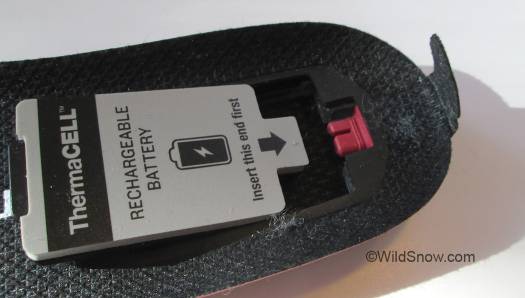
Battery inserts to connect to the red connector which appears to be a sealed ‘weatherpack’ type connector. Nonetheless we’d recommend a dab of dielectric grease.
We field tested the Thermacell in a variety of situations. WildSnow blogger Joe Risi used them in his tight and cold Dynafit ski boots during a long day of skimo race support here in Colorado, while Lisa and I’ve had them in both ski boots and work boots. They don’t produce what we’d call a huge amount of heat (they can’t, as the battery is small and you need it to last). Yet installed and used properly, you get a noticable warmup (they say “100 degrees”) and around four hours of on time at the medium setting, depending on age and temperature of batteries.
Four hours may not sound like much time, yet by turning the insoles on only when needed you can extend the benefits out to a full day. (The on/off switch is a small remote control you can hang from a pack strap or tie to a string in your pocket. If you do want to max out, a set of spare batteries weighs 1.9 ounces, (54 gr), small, they’ll fit in any pocket or take nearly zero room in your repair kit (caveat on battery swapping, see below).
In my view, Thermacell Proflex work best when used in a boot that’s already optimized for warmth. If a boot is too tight and thin in the toes and forefoot, thus cold, you’ll have to leave the heaters on continuously and you’ll run down the batteries. That’s assuming you’re out for more than a few hours. A quick tour or ride on the chairlift? Just invoke the electrons and enjoy.
Field swapping Proflex batteries is doable but problematic. You have to take your boot off, reach inside, and pull a tiny ledge on the battery with your fingertip. This can’t be done with gloves, and could even be tricky with cold hands as you have to get it just right and pop the battery out. Inserting fresh batteries is easier yet could still be too fiddly in a desperate situation. (What someone should do is make a ski boot with this system molded into the liner, with an exterior accessible battery compartment on the liner cuff. Heaven.)
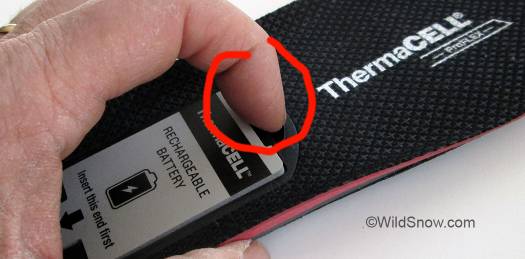
Swapping the battery is not glove friendly. We’d recommend Thermacell would include a better grab tab on the batteries. The situation is exacerbated when your boot liner squeezes the flexible insole and presses against the sides of the battery.
The batteries lose 2% charge per hour when inserted and set to “No Heat,” which is actually a sleep mode. When removed from the insole they’re truly “off” and probably lose very little power in a practical sense, though you’d want to recharge after extended storage.
Moisture intrusion and corrosion of the battery connector could be a concern, so I’d recommend a dab of dielectric grease on the connectors. Boot fitting could be an issue, as the Proflex insole adds 13.4 millimeters under your heel and 6.8 mm under your forefoot. Thus you’re dealing with added ramp (<> 6.6 mm) as well as stack. (note that thickness varies with exact measurement points, as nearly the whole insole is tapered in thickness from heel to toe.)
Depending on foot volume and boot geometry, the added thickness may be acceptable — or it could be a deal breaker. At the least, you’ll want to jerk out your existing footbeds and heat-mold your liners with the Proflex. Beyond that, find a boot with adequate volume and a customizable boot board, and do more extensive mods. I just happened to have the perfect boot for that purpose, a Scott Cosmos 2 with the classic “Garmont” last and a removable boot board. Follow along.
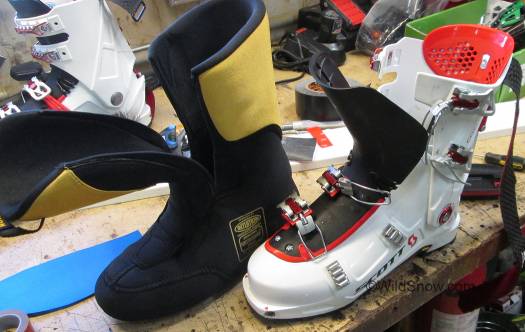
Cosmos 2 and a highly moldable Intuition Luxury Liner. Due to the thickness of the Proflex insole I wanted something with a highly compressible area under the foot.
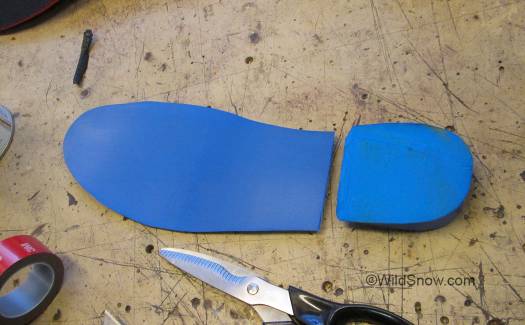
Scott Cosmos lends itself to this kind of customization due to having a removable boot board. I cut the front part of the boot board off to allow max volume. The heel pad was trimmed down so it matched level with the exposed boot bottom, and re-installed. Overall this increased the boot volume to perfectly accommodate the thick Proflex, as well as compensating somewhat for added thickness under the heel which (undesirably in many cases) increases interior boot ramp angle.
Exact added weight of the Proflex is hard to figure, as you’ll probably get rid of some boot board as well as chucking your normal footbed (stock or otherwise). As a rule of thumb, if you strip out some parts figure you’ll add about two ounces per boot. Weight of one stock Thermacell, with battery, is 3 ounces (size small). That’s a small price to pay for feet being safe and snug, but is quite a bit of lug as a percentage in a superlight boot. What Thermacell should do is make replacement lightweight insoles without batteries, that the user can swap in when they don’t need footwarmers. That way you’d get your hard earned (and sometimes costly) custom fit when you don’t need the warmers and want the least mass.
Get a set to begin customizing for next winter, or perhaps you’ll still be skiing for a few more months and want the warmest feet?Shop for em!
WildSnow.com publisher emeritus and founder Lou (Louis Dawson) has a 50+ years career in climbing, backcountry skiing and ski mountaineering. He was the first person in history to ski down all 54 Colorado 14,000-foot peaks, has authored numerous books about about backcountry skiing, and has skied from the summit of Denali in Alaska, North America’s highest mountain.

